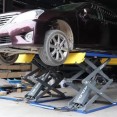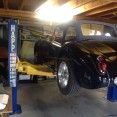Pdf versions of this list is provided to HAPP customers / potential customers on request or on the HAPP online information dashboard. If you would like to talk directly to HAPP about your questions please do not hesitate to call us on the numbers listed at WWW.HAPP.COM.AU or on the HAPP documents / advertisements you have.
Typical questions
- How hard is it to install a HAPP hoist?, can I do it myself?
- What is the difference between HAPP hoists and other hoists?
- How do the HAPP Safety mechanisms work?
- Are HAPP hoists designed to Australian Standards ?
- Can I alter the size of a HAPP hoist ?
- What is the lifting capacity of HAPP hoists?
- Can I lift very low cars, below the pad height?
- What size dyna bolts do I need?
- Can I get extra dyna bolts?
- Can I use chem set fasteners?
- Do you install hoists?
- What is the safety mechanism on the HAPP hoist?
- Do you provide asymmetric arms for HAPP hoists?
- What is the advantage of single point safety release?
- I suspect my cement is not thick enough, what can I do?
- My floor is uneven can I do anything?
- Can you supply 3 phase motors? When would you recommend 3 phase?
How hard is it to install a HAPP hoist? Can I do it myself?
It is not hard to install a HAPP hoist. Scissor lifts and our HAPP 90 are the easiest to install requiring just one person to connect fittings etc. Two post lifts and four post lifts are best constructed with the help of a friend (or two).
We ship hoists with the columns already constructed, the main installation tasks are to position the columns in the correct location and connect the fittings between the columns. We have instruction manuals written in Australia that advise how to prepare your building and options for installation. Each hoist also comes with an instruction manual specific to the hoist. And finally you have access to the HAPP technical support if you have questions on any hoist. For those who wish to see a constructed hoist you can contact HAPP to visit our show room where you can see the installed hoist and components.
You can install the hoist yourself, for businesses and those who do not have the time can use a hoist installer. HAPP have registered installers in different locations that can help if required. Businesses should note that for Australian Standards and Workplace Health and safety the requirement is that your hoist is installed (and maintained) by a ‘competent’ person.
What is the difference between HAPP hoists and other hoists?
- Designs are shared between Australia and China, Australian design engineers work directly with Chinese partners to build hoists specifically for HAPP’s Australia and New Zealand customers.
- Inspected by Australian highly qualified registered engineers
- Using thicker steel in columns, base plates and arms
- Higher quality material in structural and safety mechanisms
- Tested physically to lift much higher than the 4T stated capacity by EU testing specialists
- Structural stress tested in Australian engineering test beds
- Have key materials tested in NATA registered laboratories
- Manufactured in ISO 9001 accredited facilities
Are HAPP hoists designed to Australian Standards?
The HAPP 25, 40,70 models are designed and approved to Australian Standards, hoists imported from August 2013 shipment onwards are certified to Australian Standards. The design points used for these hoists are incorporated into all HAPP hoists. If you want workplace health and safety registration, this is available on the 25, 40 and 70 model hoists out of August 2013 shipment onwards and is provided by supplying the serial number to HAPP, the serial number is checked against the design and appropriate stickers, documents and log books for operation and maintenance of the hoist are provided. This is full design certification by registered independant engineering companies which will meet any investigation into your workplace. Beware of companies that have not paid this attention to detail.
The Australian Standards HAPP hoists are being designed to are:
- AS/NZS 1170.1 2002 Structural design actions – Permanent and other actions
- AS/NZS 1418.2 2002 Cranes, Hoists & Winches – General requirements
- AS/NZS 1418.9 1996 Cranes – Vehicle Hoists
- AS/NZS 2550.9 1996 Cranes – Safe use of vehicle hoists
- AS 3990 1993 Mechanical equipment – Steelworks
- AS 4100 1998 Steel structures
HAPP hoists are also designed and tested to the following international standards.
- EN 6024-1 2006
- EN 60204 -A1 2009
- EN 1493:2010
The manufacturing process is conducted under the international standard ISO 9001:2000
How do the HAPP Safety mechanisms work? Can I do it myself?
Can I alter the size of a HAPP hoist?
Yes, designs can be modified and re-certified to meet your needs. This can range from small changes to match your building or significant reconfigurations. For example in Motor racing, trailers can be fitted with reconfigured HAPP hoists to match your requirements and be certified by our engineers to safety standards.
What is the lifting capacity of HAPP hoists?
Most HAPP hoists are designed as 4T hoists, which means they have been tested with much heavier loads in structural and physical tests, hoists that claim this capacity may not have not been tested with heavier loads or even the specified capacity. The design principles used for Australian standards testing are incorporated into all HAPP hoists.
Can I lift very low cars, below the pad height?
Yes. Typically custom low cars only require a raise of 10-20mm to fit on a hoist. For these low cars the hoists HAPP provide special low profile ramps that allow low clearance cars to be lifted. Customers have also used wooden planks to achieve the same result. Note: HAPP research has shown that arms that fit under low clearance cars are typically not strong enough, we will not supply this style of arm.
What size dyna bolts do I need?
Dyna bolts are supplied with the hoists and extra dyna bolts are available in both dyna and loxon designs if required.
Can I get extra dyna bolts?
Yes, both Loxon and Dyna bolts are available.
Can I use chem set fasteners?
Yes, chem set fasteners can be used.
Do you install hoists?
We have registered installers in various locations across Australia. We also provide telephone level technical support for those installing their own hoist.
What is the safety mechanism on the HAPP hoist?
Each column has its individual safety mechanism, the mechanism is a ratchet style that engages every 50-100mm depending on model.
On two post hoists there are two safety mechanisms, on four post hoists there are four safety mechanisms. (scissor hoists only need one safety ratchet which is visibly locked into position.)
Do you provide asymmetric arms for HAPP hoists?
Yes, HAPP hoists have arms that are a shorter on the front side of the hoist to allow the car to be balanced correctly on the columns. Cars typically lift with the column in the middle of front seat position on car.
What is the advantage of single point safety release?
Dual point release models have cables to release the safety on each column, single point safety release models allow the release of all safety latches from one position.
I suspect my cement is not thick enough, what can I do?
HAPP provide a number of options for customers:
- Big base plates 700mm x 700mm x 16mm provide a large base
- Brace arms for front to back support
- Brace arms for front to back and side to side support
My floor is uneven can I do anything?
Yes you can, contact HAPP technical department and discuss your challenges as the solution will depend on your environment.
Can you supply 3 phase motors? When would you recommend 3 phase?
Yes 3 phase motors are available, there is no change in operation with 3 phase and power usage difference is minimal. Use 3 phase if your electrical wiring is better suited to 3 phase.
Featured Products
 HAPP12: 3T full height scissor lift, WH&S appr – SAVE $1000! Now $4990 + FREE Parts Carrier
HAPP12: 3T full height scissor lift, WH&S appr – SAVE $1000! Now $4990 + FREE Parts Carrier HAPP25: 4T Four Post, 2000mm lift, approved by WH&S – SALE $3800 WOW!
HAPP25: 4T Four Post, 2000mm lift, approved by WH&S – SALE $3800 WOW! HAPP30P: 4T 2 post floor hoist, 1.9m lift, WH&S approved – $200 OFF & FREE Parts Carrier!
HAPP30P: 4T 2 post floor hoist, 1.9m lift, WH&S approved – $200 OFF & FREE Parts Carrier! HAPP90: 2 post electric – hydraulic lift, free standing hoist, Adjustable width – $3690, FREE Seat!
HAPP90: 2 post electric – hydraulic lift, free standing hoist, Adjustable width – $3690, FREE Seat!